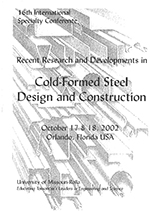Session Dates
17 Oct 2002
Abstract
The 1 1/2" composite deck section is among the more popular floor systems used in the construction of steel buildings in North America. The shear-bond between the steel deck and the concrete normally controls the capacity of a composite floor slab. Shear-bond can, for the most part, be attributed to the presence of mechanical interlock that results from the use of embossments formed in the deck webs during the rolling process. However, the extent of shear resistance between the concrete and the steel can also vary depending on the deck profile, steel thickness and grade, coating, as well as the deck position, i.e. normal or inverted. In addition, the curing time of the concrete may influence the shear resistance of the composite slab. This paper describes the results of two research projects in which the effect of some of these variables on shear-bond capacity was evaluated.
Department(s)
Civil, Architectural and Environmental Engineering
Research Center/Lab(s)
Wei-Wen Yu Center for Cold-Formed Steel Structures
Meeting Name
16th International Specialty Conference on Cold-Formed Steel Structures
Publisher
University of Missouri--Rolla
Document Version
Final Version
Rights
© 2002 University of Missouri--Rolla, All rights reserved.
Document Type
Article - Conference proceedings
File Type
text
Language
English
Recommended Citation
Tremlay, R.; Gignac, P.; Degrange, G.; and Rogers, Colin A., "Variables Affecting the Shear-bond Resistance of Composite Floor Deck Systems" (2002). CCFSS Proceedings of International Specialty Conference on Cold-Formed Steel Structures (1971 - 2018). 4.
https://scholarsmine.mst.edu/isccss/16iccfss/16iccfss-session9/4
Variables Affecting the Shear-bond Resistance of Composite Floor Deck Systems
The 1 1/2" composite deck section is among the more popular floor systems used in the construction of steel buildings in North America. The shear-bond between the steel deck and the concrete normally controls the capacity of a composite floor slab. Shear-bond can, for the most part, be attributed to the presence of mechanical interlock that results from the use of embossments formed in the deck webs during the rolling process. However, the extent of shear resistance between the concrete and the steel can also vary depending on the deck profile, steel thickness and grade, coating, as well as the deck position, i.e. normal or inverted. In addition, the curing time of the concrete may influence the shear resistance of the composite slab. This paper describes the results of two research projects in which the effect of some of these variables on shear-bond capacity was evaluated.



